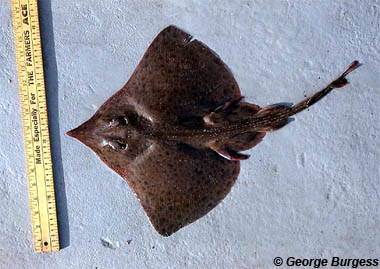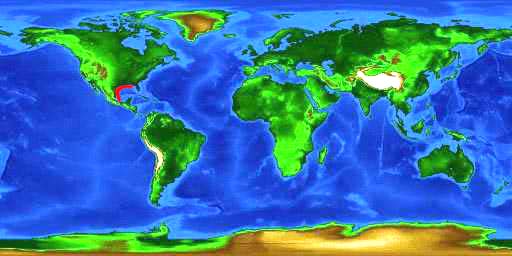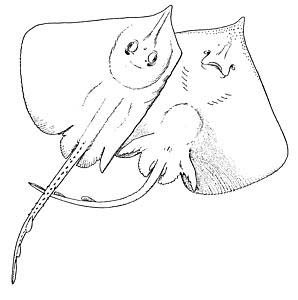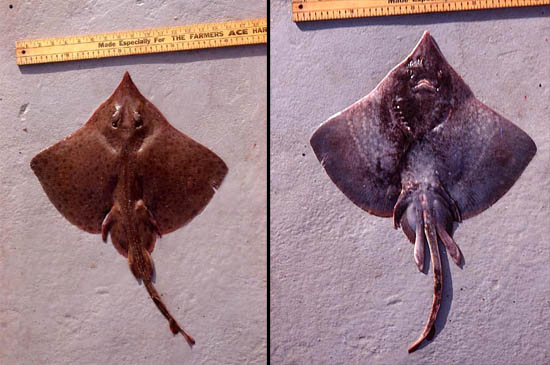Spreadfin Skate

Dipturus olseni
These deep-water, Western Atlantic skates have very pointed snouts, with triangular pectoral fins that are slightly concave at the front and rounded at the back. They have denticle thorns and small dorsal fins on their slender tail, and not many thorns on its pectoral disc, which is dark brown on top and gray to black underneath. Skates lay small, leathery egg cases but not much detail is known about their behavior of life cycle through adulthood. They can grow to almost 24 inches long but are considered harmless to humans.
Order: Rajiformes
Family: Rajidae
Genus: Dipturus
Species: olseni
Common Names
The English language common names for this species are the spreadfin skate and Olsen’s wingedskate. Other common names include raya colona (Spanish) and spreidvinrog (Dutch).
Importance to Humans
There is a lack of information regarding the commercial and recreational fisheries importance of the spreadfin skate.
Danger to Humans
Skates are completely harmless to humans since they lack a stinging spine and they can be handled without fear of injury.
Conservation
> Check the status of the spreadfin skate at the IUCN website.
The spreadfin skate is not listed on the World Conservation Union (IUCN) Red List as an endangered or threatened species. The IUCN is a global union of states, governmental agencies, and non-governmental organizations in a partnership that assesses the conservation status of species.
Geographical Distribution

The spreadfin skate is found in the western central Atlantic Ocean from off the panhandle of Florida to Texas and Mexico in the northern Gulf of Mexico.
Habitat
A relatively deep water species, the spreadfin skate resides along the outer continental shelf and upper slope at depths ranging from 180-1,260 feet (55-384 m). There is very little known about the biology of this species.
Biology

Distinctive Features
As with all skates in the family Rajidae, the body is depressed with the head, trunk, and pectoral fins forming a rhombic-shaped disc. The broad pectoral fins are fused to the sides of the head and trunk from near the snout to the insertion point of the pelvic fins. The moderately slender tail is distinct from the disc with a narrow longitudinal fold along each side. The eyes and spiracles are located on top of the head with the spiracles located directly behind the eyes. The snout is relatively long and slender. The nostrils are small and located near the front of the mouth. The two dorsal fins are located along the dorsal surface of the tail with an interspace between the dorsal fins equal to or greater than the length of the first dorsal fin base. The caudal fin is located near the tip of the tail.
The spreadfin skate is easy to distinguish from other species, as it is the only skate that lacks thorns on the disc posterior to the spiracles.
Coloration
The dorsal surface of the spreadfin skate is dark brown to olive-brown with irregular dark blotches and light-colored ampullary pores. The ventral surface is gray to jet black in color.

Dentition
The mouth of the spreadfin skate contains teeth characteristic of the family Rajidae. The numerous small teeth are single-cusped and arranged in bands forming a pavement useful in crushing prey items.
Denticles
There are three rows of thorns on the tail however there is a lack of thorns along the midbelt of the disc from the axils of the pectoral fins to the spiracles. The skin along the ventral surface is smooth.
Size, Age, and Growth
The maximum reported size of the spreadfin skate is 23.6 inches (60 cm) total length. Males mature at a total length of 20 inches (51 cm).
Food Habits
There is a lack of information regarding the food habits of the spreadfin skate. However, potential prey items include benthic marine invertebrates and small fishes.
Reproduction
All skates are oviparous and release large leathery egg capsules into the benthic environment. The egg cases are secured to substrate with horn-like projections. The embryos feed solely on the yolk within the egg case until they hatch. Very little is known about the reproductive biology of the spreadfin skate.
Predators
Potential predators of the spreadfin skate include large fish such as sharks.
Parasites
A documented parasite of the spreadfin skate is the monogenean Calicotyle kroyeri.
Taxonomy
Bigelow & Schroeder originally described the spreadfin skate as Raja olseni in 1951. However, this name was later changed to the currently valid Dipturus olseni (Bigelow & Schroeder 1951). The genus name, Dipturus, is derived from the Greek “di” meaning two and “pteryx” meaning fin.
Prepared by: Cathleen Bester